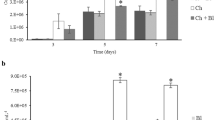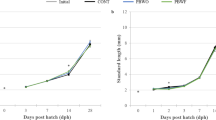Abstract
Mud crabs (Scylla) are promising aquaculture crustaceans due to their fast growth and good market demand. High rates of larval mortalities associated with bacterial diseases in hatcheries are one of the major obstacles to the growth of Scylla aquaculture. Currently, antibiotics are used extensively in Scylla larval culture to improve survival rate, but its use poses numerous risks. The aim of this study was to determine the culture performance of Scylla paramamosain larvae with the use of a probiotic, namely a multispecies Bacillus, at various concentrations. In this study, the effects of Bacillus spp. were tested in three trials. There were higher average larval survivals in treatments with a multispecies Bacillus probiotics added compared with the control, especially at concentrations of 1.00 × 104 (12.33–18.33 ± 1.76–3.76 % compared to 1.67–3.67 ± 1.67–1.76 %; P < 0.05) and 2.00 × 104 cfu/ml. This was significantly lower than the control (1.33 ± 1.33 cfu/ml compared to 32.67 ± 11.05 cfu/ml) during the later days post-hatching. Green colonies Vibrios are known to be pathogenic to Scylla larvae, and thus lower numbers are desirable in culture. The recommended concentration of the multispecies Bacillus to be added into S. paramamosain larvae was therefore 1.00 × 104 and 2.00 × 104 cfu/ml (0.50 and 1.00 g/50 l, respectively). The use of Bacillus as a probiotic is an ideal alternative to antibiotics in Scylla hatcheries to provide a consistent, commercially feasible production of seedlings.



Similar content being viewed by others
References
Alcaraz G, Carrara CX, Espinosa V et al (1999) Acute toxicity of ammonia and nitrite to white shrimp Penaeus setiferus postlarvae. J World Aquac Soc 30:90–97
Brick RW (1974) Effects of water quality, antibiotics, phytoplankton and food on survival and development of larvae of Scylla serrata (Crustacea: Portunidae). Aquaculture 3:231–244
Decamp O, Moriarty DJW, Lavens P (2008) Probiotics for shrimp larviculture: review of field data from Asia and Latin America. Aquac Res 39:334–338
Donnet-Hughes A, Rochat F, Serrant P et al (1999) Modulation of nonspecific mechanisms of defence by lactic acid bacteria: effective dose. J Dairy Sci 82:863–869
Food and Agricultural Organization (2013) FishstatePlus—universal software for fishery statistical time series (Software). http://www.fao.org/fishery/topic/16073/en. Cited 31 January 2015
Food and Agricultural Organization (2015) FishstatePlus—universal software for fishery statistical time series (Software). http://www.fao.org/fishery/topic/16073/en. Cited 1 July 2016
Jamari ZB (1991) Preliminary studies on rearing the larvae of the mud crab (Scylla serrata) in Malaysia. In: Angell CA (ed) Report of the seminar on the mud crab culture and trade held at Surat Thani, Thailand, November. Bay of Bengal Programme, Surat Thani, p 143
Keenan CP, Davie PJF, Mann DL (1998) A revision of the genus Scylla de Haan, 1833 (Crustacea: Decapoda: Brachyudra: Portunidae). Raffles B Zool 46(1):217–245
Kesarcodi-Watson A, Kaspar H, Lategan MJ et al (2008) Probiotics in aquaculture: the need, principles and mechanisms of action and screening processes. Aquaculture 274:1–14
Lavens P, Sorgeloos P (eds) (1996) Manual on the production and use of live food for aquaculture. Food and Agriculture Organisation of the United Nations, Ghent
Lavilla-Pitogo CR, Balticados MCL, Cruz-Lacierda ER et al (1990) Occurrence of luminous bacterial disease of Penaeus monodon larvae in the Philippines. Aquaculture 91:1–13
Lavilla-Pitogo CR, Catedral DD, Pedrajas SAG et al (2002) Selection of probiotics for shrimp and crab hatcheries. In: Inui Y, Cruz-Lacierda ER (eds) Disease control in fish and shrimp aquaculture in Southeast Asia—diagnosis and husbandry techniques: proceedings of the SEAFDEC-OIE seminar-workshop on disease control in fish and shrimp aquaculture in Southeast Asia—diagnosis and husbandry techniques, 4–6 December 2001. SEAFDEC Aquaculture Department, Iloilo City Philippines Iloilo, p 136
Luis-Villaseñor IE, Macias-Rodriguez ME, Gomez-Gil B et al (2011) Beneficial effects of four Bacillus strains on the larval cultivation of Litopenaeus vannamei. Aquaculture 321:136–144
Maddox MB, Manzi JJ (1976) The effects of algal supplements on static system culture of Macrobrachium rosenbergii (De Man) larvae. In: Proceedings on the 7th annual workshop world mariculture society, San Diego State University, 25–29 January 1976
Mann D (2001) The influence of microbiology on the success of mud crab larval culture. In: Le Vay L, Sorgeloos P, Wille M, Nghia TT et al (eds) Mud crab rearing, ecology and fisheries, book of abstracts of 2001 workshop, Can Tho University, Vietnam, 8–10 January 2001. Can Tho University, Can Tho City, p 18
Moriarty DJW (1998) Control of luminous Vibrio species in penaeid aquaculture ponds. Aquaculture 164:351–358
Moriarty DJW (1999) Disease control in shrimp aquaculture with probiotic bacteria. In: Bell CR, Brylinsky M, Johnson-Green P (eds) Microbial biosystems: new frontiers, proceedings of the 8th international symposium on microbial ecology. Atlantic Canada Society for Microbial Ecology, Halifax, p 237
Morikawa M, Ito M, Imanaka T (1992) Isolation of a new surfactin producer Bacillus pumilus A-1, and cloning and nucleotide sequence of the regulator gene, psf-1. J Biosci Bioeng 74:255–261
Neil LL, Fotedar R, Shelly CC (2005) Effects of acute and chronic toxicity of unionized ammonia on mud crab, Scylla serrata (Forskål, 1755) larvae. Aquac Res 36:927–932
Nghia TT (2005) Optimisation of mud crab (Scylla paramamosain) larviculture in Vietnam. Dissertation, Ghent University
Nogami K, Hamasaki K, Maeda M, Hirayama K (1997) Biocontrol method in aquaculture for rearing the swimming crab larvae Portunus trituberculatus. Hydrobiologia 358:291–295
Ohashi M, Murakami H, Kudoh Y et al (1978) Manual for the laboratory diagnosis of bacterial food poisoning and the assessment of the sanitary quality of food. SEAMIC, Tokyo
Parry JM, Tumbull PCB, Gibson JR (1983) A colour atlas of Bacillus species, Wolfe Medical Atlases No. 19. Harcourt Health Services, Edinburgh
Powedchagun P, Suzuki H, Rengpipat S (2011) Characterization of a probiotic Bacillus S11 bacterium of black tiger shrimp Penaeus monodon. SJST 33(1):1–8
Quinitio ET, Parado-Estepa FD (2008) Biology and hatchery of mud crabs Scylla spp, Aquaculture Extension Manual No. 34, July 2008, 2nd edition. Southeast Asian Fisheries Development Center, Tigbauan, Iloilo
Quinitio ET, Parado-Estepa FD, Rodriguez E (2002) Seed production of mud crab Scylla spp. Aquac Asia 7(3):29–31
Rengpipat S, Rukpratanporn S, Piyatiratitivorakul S et al (2000) Immunity enhancement in black tiger shrimp (Penaeus monodon) by a probiont bacterium (Bacillus S11). Aquaculture 191:271–288
Sanders ME, Morelli L, Tompkins TA (2003) Sporeformers as human probiotics: Bacillus, Sporolactobacillus, and Brevibacillus. Compr Rev Food Sci Food 2:101–110
Sapcharoen P, Rengpipat S (2013) Effects of the probiotic Bacillus subtilis (BP11 and BS11) on the growth and survival of Pacific white shrimp, Litopenaeus vannamei. Aquac Nutr 19(6):946–954
Senok AC, Ismaeel AY, Botta GA (2005) Probiotics: facts and myths. Clin Microbiol Infect 11(12):958–966
Shelly C, Lovatelli A (eds) (2011) Mud crab aquaculture, a practical manual. Food and Agriculture Organization of the United Nations, Rome
Spanggard B, Jorgensen F, Gram L et al (1993) Antibiotic resistance in bacteria isolated from three freshwater fish farms and an unpolluted stream in Denmark. Aquaculture 123(1):11–19
Talpur AD, Memon AJ, Khan MI, Ikhwanuddin M, Danish Daniel MM, Abol-Munafi AB (2011) A novel of gut pathogenic bacteria of blue swimming crab Portunus pelagicus (Linnaues, 1758) and pathogenicity of Vibrio harveyi—a transmission agent in larval culture under hatchery conditions. Res J Appl Sci 6:116–127
Talpur AD, Memon AJ, Khan MI et al (2012) Isolation and screening of lactic acid bacteria from the gut of blue swimming crab, P. pelagicus, an in vitro inhibition assay and small scale in vivo model for validation of isolates as probiotics. JFAS 7(1):1–28
Van Stappen G (1996) Introduction, biology and ecology of Artemia. In: Laverns P, Soorgeloos P (eds) Manual on the production and use of live food for aquaculture. Food and Agricultural Organisation, Rome, p 101
Vaseeharan B, Ramasamy P (2003) Control of pathogenic Vibrio spp. by Bacillus subtilis BT23, a possible probiotic treatment for black tiger shrimp Penaeus monodon. Lett Appl Microbiol 36:83–87
Verschuere L, Rombaut G, Sorgeloos P et al (2000) Probiotic bacteria as biological control agents in aquaculture. Microbiol Mol Biol Rev 64:655–671
Wu LB, Sun CB, Li ZZ et al (2014) Enhancement of the immune response and protection against Vibrio parahaemolyticus by indigenous probiotic Bacillus strains in mud crab (Scylla paramamosain). Fish Shellfish Immunol 41:156–162
Yeh SP, Chiu CH, Shiu YL et al (2014) Effects of diets supplemented with either individual or combined probiotics, Bacillus subtilis E20 and Lactobacillus plantarum 7-40, on immune response and disease resistance of the mud crab, Scylla paramamosain (Estampador). Aquac Res 45(7):1–12
Zimmerman SB, Schwartz CD, Monaghan RL et al (1987) Difficidin and oxydifficidin: novel broad spectrum antibacterial antibiotics produced by Bacillus subtilis. J Antibiot 40(12):1677–1681
Acknowledgments
The authors would like to thank Jocelyn E. W. Goon our temporary Project Assistant under our Short Term Grant. We acknowledge the staff and students of CEMACS, USM, including the staff of “The Mud Crab Research Project”, CEMACS. This study was funded by the APEX Delivering Excellence (1002/PPANTAI/910331, USM), Short Term Grant (304/PPANTAI/6312131, USM), and the Post Graduate Research Grant Scheme (USM). The financial support of MyBrain15 (Ministry of Higher Education) and Graduate Assistant (USM) are equally acknowledged.
Author information
Authors and Affiliations
Corresponding author
Rights and permissions
About this article
Cite this article
Talib, A., Onn, K.K., Chowdury, M.A. et al. The beneficial effects of multispecies Bacillus as probiotics in enhancing culture performance for mud crab Scylla paramamosain larval culture. Aquacult Int 25, 849–866 (2017). https://doi.org/10.1007/s10499-016-0070-5
Received:
Accepted:
Published:
Issue Date:
DOI: https://doi.org/10.1007/s10499-016-0070-5




